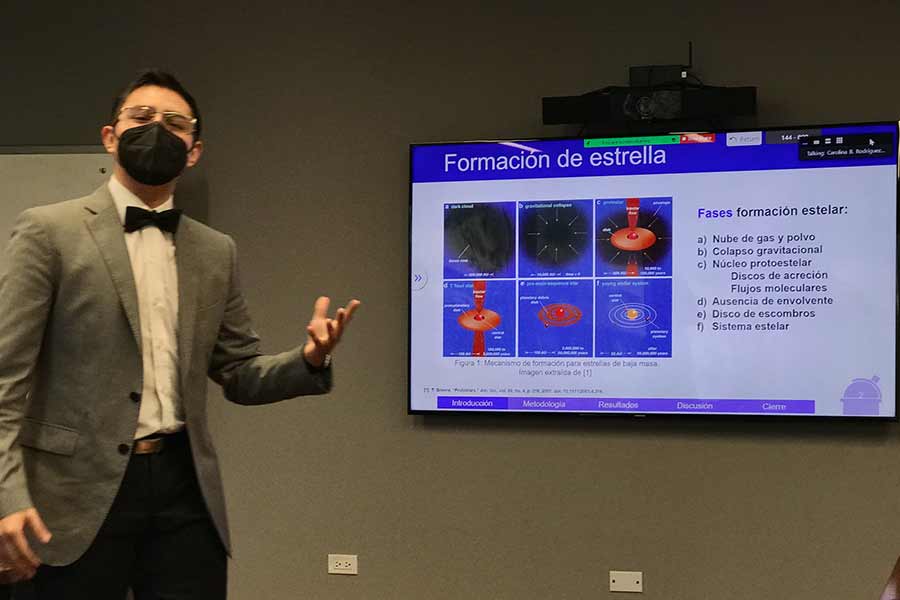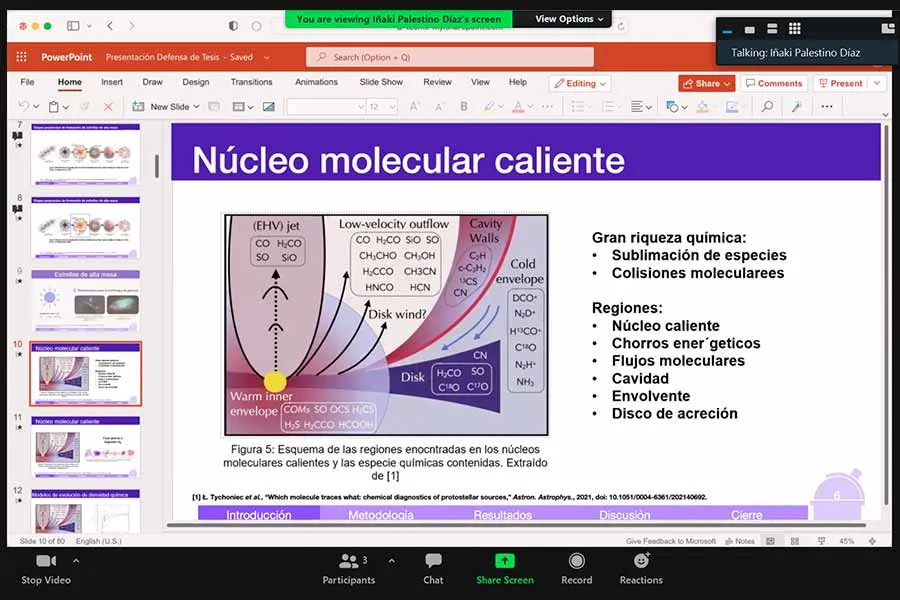Identifying eleven chemical species, in addition to reaffirming the existence of the cyanoacetylene molecule (HC3N), were the results of the first astrochemistry thesis published at Tec de Monterrey.
The author is Iñaki Palestino, a Nanotechnology and Chemical Sciences Engineering student at the Monterrey campus.
In order to obtain these results, Iñaki, who hails from Córdoba, Veracruz, analyzed data from a total of 44 massive star formation regions in our galaxy, observed from the Alfonso Serrano Large Millimeter Telescope in Puebla.
This single dish radio telescope is the largest of its kind in the world. With a diameter of 50 meters, it was used to obtain the first image of a black hole.

In the thesis, entitled “Analysis of the chemical composition of high-mass star-forming regions using the Large Millimeter Telescope,” Iñaki addresses the importance of studying the formation of high-mass stars.
“High-mass stars in particular are 8 times the mass of the sun, and they’re important for two big reasons: These stars are responsible for the formation of chemical elements beyond carbon, and they’re responsible for galaxy morphology,” he said.
This thesis was one of the requirements Iñaki had to cover before graduation.
“The sky is always calling us, and we have to explore it. It’s really nice to be able to have answers and share them with others.”- Iñaki Palestino
From dust to galaxy formation
Iñaki focused his research on the formation of massive protostars, a term that refers to the formation period which begins when a large cloud made up of gas and dust contracts until it forms a stellar core.
“Various molecules such as CO, SiO, N2H+, SO, and long-chain carbon species, in particular HC3N, appear during the formation period of massive protostars.
“Each one of these chemical species allows us to observe different phenomena associated with star formation,” said Iñaki.
However, he stressed that the HC3N molecule can be used to estimate the protostar’s age thanks to the relationship between signals detected and values derived from them, such as temperature, columnar density, and abundance.
To obtain these results, Iñaki used data collected by his thesis advisor, Dr. Carolina Rodríguez-Garza, in 2016, using the Alfonso Serrano Large Millimeter Telescope.
“The processing of this data was possible thanks to CASSIS software, which allows us to use the rotational diagram method to obtain data such as the temperature and number of molecules in a certain area of the protostars observed,” said Iñaki.
“Each one of these chemical species allows us to observe different phenomena associated with star formation.” - Iñaki Palestino

The process of deciphering precise stellar data
The selection of these protostars wasn’t at random, but was a structured process with various exclusion criteria, Iñaki explained.
“The first requirement was for these sources to belong to the IRAS (InfraRred Astronomical Satellite) catalog. This catalog was obtained by a space mission of the same name and contains data on around half a million stars.
“What’s more, we needed these stars to have been observed in the Northern Hemisphere, because the telescope’s field of view depends on the latitude at which they’re located,” he explained.
A challenge thousands of light years away
Although high-mass stars are very important, added the student, there are three main problems that make studying their formation stages difficult.
“The first of these problems is attributed to the distance at which they’re located. The second corresponds to the low temperatures found in these regions, which means it’s only possible to observe them with radio telescopes.
“Finally, the formation phases of these stars are relatively quick compared to their low-mass counterparts, so the number of candidate regions to be studied is very low,” he elaborated.
Despite this, the student acknowledged that the study of these stars is essential to understanding the morphology of the universe and answering one of astronomy’s still unanswered questions: How are stars formed?

Mentoring his journey to the stars
Carolina Rodríguez-Garza, Director of the Physics and Industrial Engineering degree program and the first female astronomer to hold this position at the Monterrey campus, was Iñaki’s thesis advisor.
“For me, Iñaki will always be a very special student because his is the first thesis I’ve supervised and none of it would have been possible without his enthusiasm and initiative.
“Also, thanks to his proactivity, one of my objectives since arriving at the Tec has been fulfilled: opening the doors to new areas of research such as astronomy,” she said.
During his time as a student at the Monterrey campus, Iñaki was part of the student chapter of the American Chemical Society, as well as interning at the Álvarez-Trujillo Lab, and he was also Vice President of the Particle Accelerator Student Community.
In 2020, he also had the chance to be one of the Space Mission coordinator students at Space Maker, a Tec de Monterrey initiative focused on developing aerospace projects.
“With such determination, I’m sure a path full of opportunities awaits him, and that he’ll achieve his goal of becoming a professional astronomer,” said the professor.
Carolina Rodríguez-Garza is also known for supporting science communication through her Facebook page, where she’s known as La Mujer Cohete (Rocket Woman).
Sharing his view of astrophysics
“Iñaki’s thesis was developed over two semesters. In the first semester, we determined the thesis proposal, with me contributing my experience in thesis advising,” acknowledged Fernando Rodríguez-Macías, Research Professor at the School of Engineering and Sciences.
In the second semester, he added, we proceeded to supervise the data analysis, with Dr. Rodríguez-Garza providing an astrophysics perspective and myself providing a chemistry perspective.
“In the end, I think we obtained important results which have contributed to better understanding star formation regions, through spectroscopic analysis with an interdisciplinary perspective,” explained the student’s co-advisor.
The professor stressed that this thesis has special meaning to him due to a historical matter related to his research paper on carbon nanomaterials, some of which could be present in interstellar space.
“For me, Iñaki will always be a very special student because his is the first thesis I’ve supervised and none of it would have been possible without his enthusiasm and initiative.”- Carolina Rodríguez
Laying the groundwork for new research
Iñaki highlighted the link between chemistry and astronomy that he explained in his thesis and pointed out the importance of documents like this one to the scientific community.
“Puebla’s telescope can be used to learn more about high-mass stars. It contributes to the most expensive scientific project in Mexico. We have this instrument that can be used to do science in our galaxy,” he said.
The student added that this step in his career is a major achievement since he considers astronomy the ultimate curiosity.
“The sky is always calling us, and we have to explore it. It’s really nice to be able to have answers and share them with others,” he said.
With information from Ángel Solís.
Don’t leave without reading:





